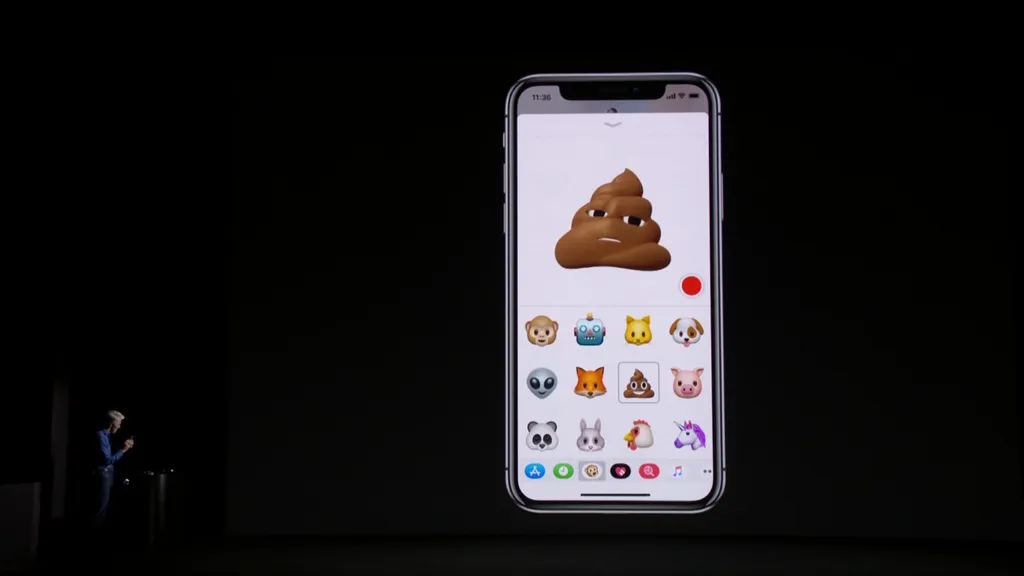People who watch technology closely — especially those optimistic about VR and AR — are scratching their heads this week trying to understand how Apple “undersold” those features so significantly.
At the Apple September Keynote, there was no mention of VR at all despite the iPhone X being the first device from Apple to use an OLED screen that would likely be ideal for completely immersive virtual worlds. And with AR, Apple showed its most advanced iPhone making use of its 2015 purchase of Faceshift. This technology enables intricate facial expressions to be transferred in real-time onto a cartoon character. Apple demonstrated it by animating poop and other emoji.
While it is easy to joke about this feature, I look forward to using it enormously.
That said, iPhone X is too expensive for me at the moment, and at first glance the improvements over the more traditional iPhone 8 Plus don’t seem significant enough. Then again, I haven’t set eyes on it myself nor has anyone had the opportunity to do a proper review. Nonetheless, my initial reaction says nothing of its potential in the market. There are plenty of folks out there who will see the benefits of this lighter, larger-screened gadget and its world-class outward-facing camera as the perfect companion for the next year or two. In all likelihood, when it arrives in November sales of iPhone X will only be constrained by the number Apple is able to build.
Logistically, iPhone X uses different components from other devices in the iPhone’s lineup — critically that OLED screen. The high price of the device also means fewer people can afford it so Apple can still ship it worldwide at lower volumes. If Apple can bring in another supplier of OLED screens besides Samsung, like LG, you can expect certain aspects of the iPhone X to make its way down to less expensive and higher volume phones in the coming years.
From a market perspective, Apple just pushed iPhone into a new segment. And that segment could become incredibly important in future generations as more features are tacked onto the high-end iPhone. For Apple, iPhone X lays important groundwork for years to come.
AirPods, Apple Watch And Eventually Glasses
The below tweet is, at first glance, a very good joke:
2016: lets take away the aux
2017: lets take away the home button
2018: lets take away the screen
2019: pic.twitter.com/NAEQVxlzKZ— dead inside (@blackvial) September 12, 2017
But it speaks to some legitimate long-term trends underway as we move toward the next generation of computers. In many cases, Apple’s gadgets know more about you than you know about yourself. Over time, powered by Siri’s artificial intelligence, the company will start to surface more and more of that information in ways that help you. And even as the technology learns more about you, the 21st century trend is toward computers that are more and more invisible. This is what we’re seeing as the phone disappears more and more.
There is very likely a future where some combination of earbuds, watch and glasses form the basis of what is sometimes referred to as an “ambient” computing platform. Think of it like Star Trek’s computer, where it is there to answer your question at any moment. But instead of this computer being tethered to a spaceship, you’ll have your answer no matter where you are or what you are doing.
The other major addition Apple announced this week was cellular connectivity on the Apple Watch. With a pair of AirPods added, Apple debuted a first-generation of this truly wireless ambient computing system. Listen to music, take calls, ask a question or just forget you have a highly advanced computer system strapped to your body and waiting to respond to you at any moment.
Battery Life Is The Key
What is easily overlooked in this evolution is one of Apple’s greatest innovations over the last few years. The company is developing its own silicon to extend battery life, allowing it to put cellular connectivity in a device as small as a watch. As time progresses, this aspect of Apple’s development may be the most important part of any glasses or cellular-capable earbuds that might emerge to make ambient computing more flexible and usable.
We have to think about battery life as we consider the prospect of any company one day making phones obsolete by delivering great AR glasses. Phones are great at letting people read, surf the web, watch movies or connect with friends. Great AR glasses should be able to do this and a hundred other things that change our lives with the added convenience of being delivered straight to the eyes. The core enabling feature of this technology, though, will be how efficiently these devices consume electricity.
Just today we’ve heard Florida-based Magic Leap is again looking to add to the $1.4 billion in funds it already raised on a path to delivering a first generation developer kit that is unlikely to be as slim and comfortable as would be required in consumer AR glasses. For the whole thing to function you might need to store a battery and processing pack in your pocket, or worse, strapped to your back, with a wire running to the glasses. And this is from a company exclusively focused on solving this problem for more than five years.
Which brings me back to why Apple may have “undersold” the AR features of new iPhones. Something that can truly change our lives for the better — like being shown step-by-step directions to a place you want to go on the road in front of you — is an enormous undertaking. Google teased the feature for a long time now with its Tango devices, but instead of rolling it out to more high-end devices, we instead saw Google take a step backward and roll out “fun” AR features more broadly across the Android ecosystem with ARCore.
It is my guess that as we move into the next few years of personal computing, higher cost phones in the iPhone X segment or above will be the bridge to compelling AR. ARKit and ARCore from Apple and Google respectively are about kickstarting development with playful applications so when more compelling devices arrive — whether phones or glasses — they are flush with applications that can change our lives. As Adi Robertson at The Verge noted, “ARKit has a lot of potential uses, but many of them are still pretty silly, which sits uneasily alongside lofty rhetoric about the future of computing.”
Apple’s evolution into AR and VR might start with animated poop that seems to speak to some flaw in our selfie-obsessed culture, but that’s just a starting point. Too much of Apple’s foundation is rooted in helping professionals and students with their creative expression for it to stop here. Apple is leading the way developing core technologies like silicon that allow it to maximize battery life for very specific use cases. It’s my hope that as time progresses creative expression remains one of those core uses. We’re seeing VR used for enormous leaps in creative expression, from Tilt Brush and Blocks to Mindshow and Medium, and I would be very surprised this is going unnoticed by Apple.
People wishing Apple had been more “bold” in its 2017 releases need to recognize that compelling mass-market AR and VR — stuff that can ship at the volume of phones, PCs or consoles — requires better hardware that simply doesn’t exist yet. That doesn’t mean current AR and VR isn’t good, just that it isn’t good enough to appeal to tens or hundreds of millions of people. What we saw this year instead was Apple laying the groundwork for this roll-out in the years to come.




























